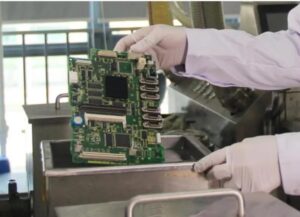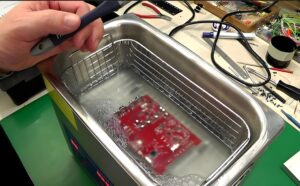For a considerable period of time, the industry’s understanding of cleaning processes was not sufficient. Mainly because in the past, the assembly density of PCBA was relatively low, and the adverse effects of pollutants such as flux residue on electrical performance were not easily detected. Nowadays, with the development of miniaturization in the design of PCBA, the device size and spacing between devices have become smaller. Failure faults such as short circuits and electrochemical migration caused by small particle residues have attracted widespread attention. In order to adapt to market trends and improve product reliability, more and more SMT manufacturers are embarking on a journey of learning about cleaning processes.
The cleaning process is the process of combining the static cleaning force of the cleaning agent with the dynamic cleaning force of the cleaning equipment to ultimately remove pollutants. PCBA cleaning is divided into two stages: SMT and THT. By cleaning, the accumulation of surface pollutants during the processing of the product can be removed, reducing the risk of surface contamination and reliability. In the electronic manufacturing and semiconductor processing industries, it is crucial to choose the right cleaning agent and appropriate cleaning equipment. The factors that affect the stability of the PCBA cleaning process mainly include: cleaning objects, cleaning equipment, cleaning agents, and process control.
Cleaning objects
In general, the cleaning objects are residual solder paste and flux, which can cause electrochemical migration, corrosion, and short circuits, posing a great threat to product reliability. However, it cannot be ruled out that there may be large particle pollution, oil stains, and sweat stains on the surface of the circuit board. The material properties and surface conditions of different PCBAs also vary. In many cases, the customer’s product cannot enter water, so immersion cleaning process is not suitable! In addition, some components are made of sensitive metals and are very fragile. Ultrasonic cleaning cannot be used, otherwise those bubbles will shatter the components when they explode. Some components must be treated gently with pH neutral cleaning solution! Usually, circuit boards have very complex geometric structures on their surfaces, and the integration density is also very high. When the distance between the device and the substrate is very small, the droplets of deionized water cannot penetrate the small gaps and are unable to remove the pollutants at the bottom of the device. In this case, chemical cleaning agents are needed to help.
Cleaning agent
Choosing a specialized cleaning agent is very important, and material compatibility is often overlooked but crucial in the cleaning process. For example, there are various metal materials such as copper, nickel, or aluminum on the packaging of power modules. Improper cleaning processes can easily lead to corrosion or oxidation of aluminum chips and copper surfaces, and some may even result in character detachment. Therefore, material incompatibility between cleaning agents and cleaning objects, as well as between cleaning agents and cleaning equipment, may lead to product scrapping or blockage of equipment pipelines.
Cleaning equipment
A complete cleaning process usually includes three steps: cleaning, rinsing, and drying. During the cleaning process, the cleaning agent and pollutants come into contact with each other, and the cleaning agent separates the pollutants from the surface of the cleaning object; The rinsing and drying process is mainly to further remove pollutants, and also to ensure that there is no residual cleaning agent on the surface of the components.
Cleaning process control
As the cleaning time increases, the pollutants continuously entering the cleaning solution will have a negative impact on the cleaning efficiency. When should I change the liquid? When is the latest time to change the liquid? How to adjust the cleaning parameters when the environment/product has changed? These issues directly affect the cost and output of customers, and the key to finding the answer lies in the collection of cleaning data, including time, action, concentration, and temperature. The cleaning solution is affected by many factors during use, such as residues in the liquid, evaporation of the liquid, and the addition of deionized water, and its concentration often fluctuates. So in the circuit cleaning process, the monitoring of concentration is directly related to the stability of the cleaning effect.
















